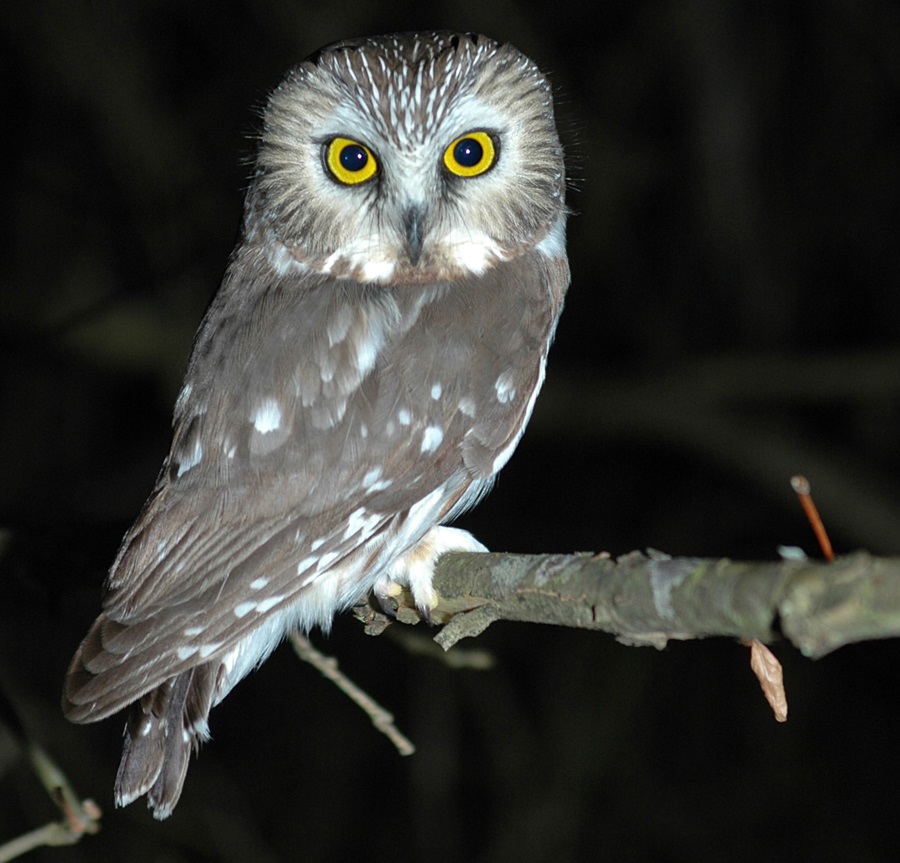As the sun sets on a late fall evening, an unfamiliar silence falls on the marshes of Wellfleet. The frogs, whose calls are inescapable all summer, are silent now, and the night-singing birds like rails and marsh wrens have mostly gone. All that’s left are the chittering of flying squirrels, the distant hum of Route 6, and, if you’re lucky, the strange groans and squeals of fall owls.
In late November, I went out to the Herring River with my friend William Freedberg, a fellow birder from Eastham. It was the perfect night to look for owls: it was fine weather: brisk but not too cold, and there was no wind. We would be happy with any owl we might find, but there was one bird we really wanted: the northern saw-whet owl.
Most people’s mental image of an owl is a hulking, brutish raptor. Some Outer Cape owls, like great horned, match this description, but not saw-whets. From nose to tail, they are no longer than a pencil, and they weigh about as much as a small apple. Their warm brown plumage and big doe eyes only add to their adorableness. It’s not hard to see why people love these birds so much.

Every fall, saw-whet owls migrate onto Cape Cod from their breeding grounds up north, and they congregate in significant numbers along the Herring River estuary throughout the winter. From High Toss Road to the Wellfleet-Truro town line, you can see a dozen or so of these tiny predators on a good night. They prefer the highlands above the marsh, but occasionally they will be found right down against it.
As we drove slowly along Pole Dike Road with the windows open, cold air blowing into the car, we stopped periodically to listen. Saw-whets make a strange assortment of sounds: long series of toots, high whistles, sputtery twitters, and one grating call that sounds like a saw being sharpened. This final call gives them their name.
Despite our best efforts, these stops produced no sign of owls. Our birdwatching-by-car method was clearly not working. We decided to continue on foot.
We parked near the intersection of Bound Brook Island and Pamet Point roads and began walking uphill, stopping to listen every few minutes. The Moon was so bright that we could see ahead without a flashlight. After we had been walking for about 15 minutes, we stopped at the crest of the hill.
Suddenly, we heard it: a distinctive, three-whistled series, coming from a tree about 100 feet away. It was a saw-whet owl.
William and I froze. I took out my phone and pulled up a recording of a saw-whet owl. I pressed play and let the recorded call ring out for about five seconds. I paused, hoping the bird would come investigate the source of the call. Ten seconds passed. Twenty. Thirty.
Suddenly, the owl called again, directly over our heads. William took out his flashlight and aimed it at the branches. He turned it on.
I wish I could tell you we saw two big yellow eyes staring back at us. We didn’t. The owl was either too high up or too well hidden for us to see. After some scanning, we turned the light off. The owl had gone quiet.
Using these tools — a recording and a flashlight — raises some ethical questions. Owls are popular with photographers, and people seeking a good photo will sometimes harass these birds so much that they have no time to eat. A lot of online bird groups have rules against posting owl photos to discourage this behavior.
In general, these tools are best used judiciously. Use a flashlight only long enough to get a good look, then turn the beam off. And with recordings, you want to play a few seconds worth, then pause it. Once a bird has come in and then retreated, move on.
Later, we heard a second saw-whet owl, well up a cart path off Old County Road. But try as we might, we never got to see it.
This experience is typical of what happens when you look for owls at night. Hearing them is possible with a little bit of effort. Seeing them is much tougher.
It is possible to find owls during the day, however. Northern saw-whet owls like roosting in dense brush and hedgerows, and they have a distinct preference for cedars. With some persistence, a good birder can occasionally find one of these raptors nestled away in the brush, sleeping, and hiding from larger predators.
But owls aren’t adapted for roosting — they’re adapted for the night. Owls’ eyes are relatively huge to help them see in low light. Their distinctive round faces channel noise like a radar dish, amplifying sound on its way to their enormous ears. And they fly silently, too, either to help them hear or to keep their prey from noticing their approach. None of these adaptations helps an owl during the day. But at night, they keep these birds alive.
Finding a roosting owl will let you see one well. But if you want to understand owls, go out and find one at night.



